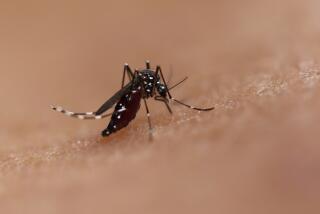Pet Owners Try to Bite Back at Flurry of Fleas
- Share via
Don’t tell anyone, but we have fleas.
Indicative of the trouble in Los Angeles this year is the complaint of Montebello veterinarian O.W. Estafanous. “We never had a worse problem,” he said. “We used to spray the dog once a week and he’d be OK. Now we are spraying the dog more often and we have a worse problem.”
But veterinarians and researchers have a message for pet owners: Not to worry, they say. Most of the commercial remedies--the dips, powders, bombs and shampoos--will make a flea flee. Used properly, these preparations will get the bugs out even though the weather has been particularly to a flea’s liking.
A Large Crop of Fleas
Observers attribute this year’s large, hungry crop of fleas to a mild 1987 winter that continually provided the warm temperatures ideal for their reproduction.
“We never got a good kill,” said Santa Monica veterinarian Dale Smith. “So we started with a bigger burden this spring and it has progressively gotten worse in the summer.”
The resulting infestation has propelled consumers into grocery stores, pet shops and veterinary hospitals looking for something, anything that would reduce the flea population in their homes.
One new product, however, has run into trouble of its own. Touted by its producer as the first insecticide to both repel and kill fleas and ticks, Hartz Blockade will soon carry a label, warning against its use on young or pregnant cats and young puppies. The new label will also state that the product should be applied lightly, without saturating, and that applications should be made not more than once every seven days.
Hartz Mountain Corp. agreed to the warning--which should be showing up on aerosol cans within a few weeks--after an Environmental Protection Agency investigation found that the flea and tick repellent had caused “definite” or “suspected” toxic effects, including 26 deaths, in 201 dogs and cats this year.
Hartz, which has been ordered by the EPA to conduct additional toxicity tests on Blockade, has issued a statement defending it as part of a group of flea killers “reputed to be among the safest insecticides available.”
That statement may or may not satisfy pet owners. But local veterinarians say that if animal lovers wish to seek other products, many effective ones are available.
The key to successful treatment, they say, is to remember that the flea spends little time on your pet. The dark, acrobatic little insect, less than an eighth of an inch long, can leap eight inches vertically or 13 inches horizontally. When it gets hungry, it does what most of us do--it eats and runs--getting on and off the animal quickly.
“A flea almost goes out to lunch on a dog or cat for a few minutes every 24 to 48 hours. He eats and goes back to the environment,” said Peter Ihrke, associate professor of dermatology at the University of California at Davis School of Veterinary Medicine.
Hundreds of Eggs
If that seems simple and innocuous enough, consider these facts: For every flea you see--on you, your animal or in mid-hop--there are 50 to 100 or more in the environment, according to people who keep track of these things. Within a single month a female flea can produ1667571816offspring may give birth to several thousand under ideal conditions.
Most eggs are laid off the animal, but even an egg laid on an animal falls off quickly. When the egg hatches, it becomes a larva, and the larva seeks a quiet place--in couches, under pillows or in pet bedding--to pupate. Fleas can live in the cocoon-like, pupal stage for more than a year, but when the highly sensitive pupa is stimulated by a vibration or a favorable change in temperature or humidity, a hopping, hungry adult flea emerges.
Because neither the flea nor the egg remain on the animal for long, experts say that the key to successful eradication is treating not only the animal but the house and the yard.
For that battleground, veterinarians reserve particular praise for insecticides that contain the generic chemical metheprine, which stops the development of the larva into fleas. And a good vacuum cleaner can be your best ally. “You must vacuum all the rugs, carpets and furniture, particularly under the cushions. That’s where the fleas will drop their eggs,” said J. W. Edwards, general manager of American City Pest Control in Lawndale.
Stopping the development of larva is not enough, however. The adult flea must also be attacked. Ihrke said, “The products we feel most comfortable with for that task are those which contain the chemical compounds pyrethrins or pyrethroids.”
Use Malathion Outdoors
When the treatment moves outdoors, the veterinarians recommend the use of a relatively safe product such as malathion, recently used to spray medflies in Los Angeles.
Of course, most animal lovers think first of providing relief for their pets rather than the environment. Many veterinarians recommend starting with a weekly flea bath, which is poured over the animal, or with a flea powder, which gets through animal’s hair, reaches the skin and may last longer than a bath.
If you’re thinking about turning to such unorthodox remedies as garlic or Vitamin B-1, best not to consult your veterinarian because the animal doctors say no reliable evidence supports the effectiveness of those treatments.
Many also are skeptical of the standard insecticide-impregnated flea collars, or the ultrasonic ones, which emit an ultrasonic wave designed to drive fleas away. Garden Grove veterinarian Wayne Rosenkrantz, a board-certified member of the American College of Veterinary Dermatology, was typical in his remarks.
“Flea collars . . . don’t work very well and I don’t recommend them,” he said. “ . . . Controlled studies show the ultrasonic flea collar may help with a very limited number of fleas, but compared to placebo collars there wasn’t any statistical difference.”
Be Careful
Whatever treatment a consumer chooses, veterinarians urge careful reading of directions and application of the product.
“If they read labels and don’t abuse it, most of those products are relatively safe,” said Garden Grove veterinarian Craig Griffin, another board-certified dermatologist of the American College of Veterinary Dermatology.
“I actually spend 15 to 20 minutes with clients going over products, how to use them properly. Then I tell them to talk to the exterminator. If the exterminator is not doing things reasonably in line with what I recommend, I tell (the clients) not to hire them.”
Both indoor and outdoor treatments are in great demand now because Southern California is at the height of a particularly difficult flea season, which normally runs from early May through late November.
A West Los Angeles animal doctor, Daniel Didden, says some animals are so severely bitten that they have to be placed in dry or mountainous areas where few fleas survive.
Bloodsucking Insects
But the bloodsucking insects plague not only animals. “The frequent complaint I get when families come in is that people are also getting bites particularly on the ankle, belt line and collar line.” Didden said.
Some pet owners develop welts and allergic reactions, but with others the effect goes deeper than the skin.
“I’ve had clients get irate and walk out,” said Santa Monica veterinarian Smith. “Sometimes they . . . think that’s a slur on the cleanliness of the house.”
Some desperate pet lovers try to overcome their problems by unconventional means. A Santa Monica poodle owner swears that if she puts a bowl of soapy water in the middle of a room before she goes to bed and shines a light on it all night, the bowl will be full of hundreds of dead fleas in the morning.
“The problem,” she says, “is that there are still hundreds of live fleas in the room.”
A San Fernando Valley woman swears that she avoids fleas because her dog swims frequently in her pool.
For all the difficulty of finding a successful remedy, however, treatment frequently works.
“With proper treatment, within a day, the dog can be comfortable to the point where he’s not biting and chewing on himself anymore,” said Juan Casillas, an East Los Angeles veterinarian.
“Within a week or two, even if the skin had become discolored, it begins to look a little healthy.”
More to Read
Sign up for Essential California
The most important California stories and recommendations in your inbox every morning.
You may occasionally receive promotional content from the Los Angeles Times.










